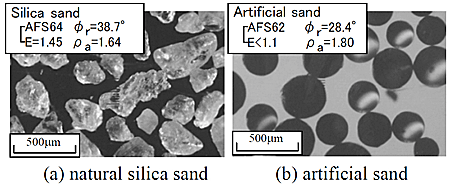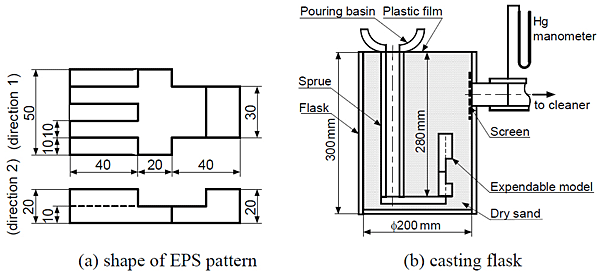The expendable pattern casting (EPC) process is very attractive, particularly for the casting with complex shapes such as automobile parts, because near net shape castings are obtained. Additionally, a good dimensional accuracy of casting is obtained. However, there are few research papers which quantitatively examined the dimensional accuracy of casting in the EPC process. As a factor affecting the dimensional accuracy of the casting in the EPC process, the deformation of the coat wall due to the load of the backpressure of the molten metal at the pouring is considered. In this study, it is thought that this deformation is affected by the sand fluidity. Since most artificial sand is spherical and has a smooth surface, it is thought that sand fluidity of artificial sand is different from natural silica sand. In this study, aluminum alloys were cast by the EPC process using simple shape expendable polystyrene (EPS) pattern and artificial sand. The effect of artificial sand filling on the appearance and dimensional accuracy of the casting was examined experimentally. Furthermore, the effect was considered from the sand fluidity and compactability.
Figure 1 shows photographs of the artificial sand and natural silica sand used in experiments. The artificial sand is a fused spherical aggregate composed mainly of SiO2 and MgO. The surface of artificial sand particles is smooth due to the surface processing. The natural silica sand used for the comparison with the artificial sand is JIS #6 silica sand.
Figure 2(a) shows the shape of the EPS pattern used in this study. The EPS pattern has relatively simple shape with ribs, is 50 mm wide, 100 mm length, and 20 mm thick, and has an expansion ratio of 60 times and a density of 17 kg/m3. The EPS pattern was made by a 3 axis machining from the CAD data, and its dimensional accuracy was within 0.1 mm of the CAD data. Figure 2(b) shows the schematic of the casting apparatus used in experiments. The steel molding flask was a cylindrical vessel with an inside diameter of 200 mm and depth of 300 mm. The cluster was assembled with the sprue, runner, and EPS pattern. The aluminum alloy JIS AC2A (A319 equivalent) was used as a casting material. The pouring temperature was set at approximately 973 K. The atmospheric pressure was applied as the condition of the pressure in the flask. The coat used in experiments is a commercial silica base coat with JIS permeability of 1.7. Two types of the casting design were used in the experiments. One of them is the vertical placement (bottom pouring) as shown in Fig. 2(b) and the other is the horizontal placement so that the rib of the EPS pattern locates the bottom surface. The dimensional accuracy of the casting was measured using a 3D laser scanner and evaluated as a dimensional difference from the EPS pattern.
Figure 3(a) shows the appearance and dimensional accuracy of the casting with the loose filling of natural silica sand. The leaching of the molten metal in the convex corner due to the crack in the coat wall, is slightly observed. Because the coat wall at this position is locally thin, it seems that the crack of the coat wall is generated by the molten metal. From the dimensional accuracy of the casting, there is a large dimensional change of positive value of approximately 0.5 mm. This positive dimensional change is due to outward movement of the coat wall with the crack in the convex corner, which is caused by the backpressure of the molten metal.
Figure 3(b) shows the same results as shown in Fig. 5 with artificial sand. Although the sand filling is loose, the appearance and dimensional accuracy of the casting are almost good. Even in the loose filling, the packed bed which is similar to closest packing can be obtained. For this consideration, it was confirmed experimentally as follows.
Table 2 shows the experimental values of the bulk density of the packing bed filled with natural silica sand and artificial sand, respectively, and shows the cases of the loose filling and tight filling, respectively. The bulk densities of the tight filling condition are larger than those of the loose filling condition, approximately 1.13 times for natural silica sand and approximately 1.05 times for artificial sand. Because the shape of natural silica sand is angular, large void is easily formed in the case of the loose filling. Therefore, the tapping increases the compactability of packed bed. However, when artificial sand is filled, even in the loose filling, the packed bed which is similar to closest packing can be obtained. And the tapping causes only small compactability.
Figure 4(a) shows the appearance and dimensional accuracy of the casting obtained by horizontally setting EPS pattern, with the tight filling of natural silica sand. "Rat" due to leaching of the molten metal in the rib on the bottom surface of the EPS pattern is observed. Even in the case of tight filling of sand, it seems that the sand filling in the rib on the bottom surface is not only locally loose, but also there is the unfilled cavity. As a result, the coat wall seems to collapse due to the backpressure of the molten metal. The dimensional difference on the bottom surface of the EPS pattern shows a large positive value even except for the part which the molten metal leaches inside the rib.
Figure 4(b) shows the same results as Fig. 4(a), with the tight filling of artificial sand. The leaching of the molten metal in the rib is smaller than the case of natural silica sand shown in Fig. 4(a). This seems to be because the repose angle of artificial sand is smaller than that of natural silica sand, so that sand flowed into the rib on the bottom surface. From the result of the dimensional accuracy of the casting, the dimensional accuracy is almost good also on the lower surface of the EPS pattern.




